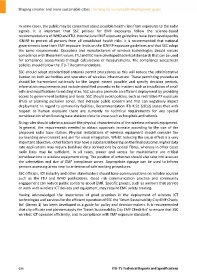Page 646 - Shaping smarter and more sustainable cities - Striving for sustainable development goals
P. 646
In some cases, the public may be concerned about possible health risks from exposures to the radio
signals. It is important that SSC policies for EMF exposures follow the science‐based
recommendations of WHO and ITU. International EMF exposure guidelines have been developed by
ICNIRP to protect all persons from all established health risks. It is recommended that national
governments base their EMF exposure limits on the ICNIRP exposure guidelines and that SSC adopt
the same requirements. Operators and manufacturers of wireless technologies should ensure
compliance with these limit values. ITU and IEC have developed technical standards that can be used
for compliance assessments through calculations or measurements. The compliance assessment
policies should follow the ITU‐T Recommendations.
SSC should adopt standardized antenna permit procedures as this will reduce the administrative
burden on both authorities and operators of wireless infrastructure. These permitting procedures
should be harmonized nationally to the largest extent possible and specify decision periods,
information requirements and include simplified procedures for matters such as installation of small
cells and modifications to existing sites. SSC can also promote an efficient deployment by providing
access to government building and lands. SSC should avoid policies, such as restrictive RF exposure
limits or planning exclusion zones, that increase public concern and that can negatively impact
deployment. In regard to community facilities, Recommendation ITU K.91 (2012) states that with
respect to human exposure there are currently no technical requirements for any special
consideration when locating base stations close to areas such as hospitals and schools.
Siting rules should take into account the physical characteristics of the wireless network equipment.
In general, the requirements needed to obtain approvals increase according to the size of the
proposed radio base station. Physical installations of wireless equipment should consider the
surrounding environment and aim for visual integration. Whilst reducing the visual effect is a very
important objective, other factors may have a substantial bearing on the final outcome. Higher data
rate applications may require backhaul data connections by optical fibres, whereas in other cases
radio links may be sufficient. In all cases, power and access for maintenance are critical
considerations in wireless equipment siting. The position of antennas should also take into account
the orientation and size of EMF compliance zones. Appropriate signage can be used to inform
persons accessing areas near to antennas of safe working procedures.
SSC officials, ICT industry and other stakeholders should base communications on reliable sources
such as the ITU and WHO publications. Good risk communication practice and community
engagement can reduce public concerns about EMF. Specific groups, such as workers that service
or work with wireless ICT devices and equipment, may require EMF safety training.
Having acknowledged the importance of good practices in the deployment of wireless ICT
technologies and services for the efficient operation of SSC the ‘Smart Sustainability City EMF Check‐
list’ (Annex 1) has been developed as a guide for policy and decision‐makers. It is recommended
that city officials and planners apply the ‘Smart Sustainability City EMF Check‐list’ to ensure that SSC
wireless ICT operates efficiently, and in compliance with EMF exposure standards.
636 ITU‐T's Technical Reports and Specifications

